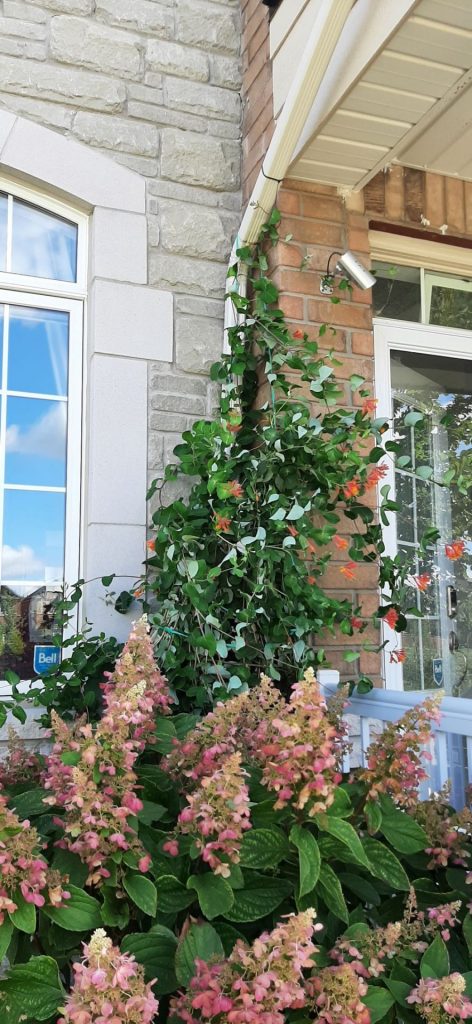
Can you suggest three disease resisteat ( japanese beattle) repeat blooming shrub roses ( bright pink, or red) tgat i can trm and keep at around 5 feet hight and 3 feet width 2. how can i help steer this honeysucjkle to climb to top of my hom e ( picture attached) – what equipment should i buy and when should i install it and trim it so it can climb. 3. when si best time to transplant a floc plant in my garden, how to do it so it will survive – thanks
Thank you for contacting the Toronto Master Gardeners with your gardening questions.
Most roses will rest for a few weeks before their second flush of flowers later in the season around August-September. The best rose that I have found for almost continuous blom and easy care is the Knock Out Rose. This rose comes in a number of different colours including a singular flowering pink, red or a double pink, red flower. In general, this rose is black spot resistant, self cleaning, and once established, drought-tolerant and hardy to zones 5-11. It grows to a mature height of 3-4’ and a spread of 3-4’. Make sure to plant roses in a location where they will receive a minimum of 6hrs of sunlight. The other advantage to this rose is that it is growm on it’s own root stock, not grafted like f]some of the other gradifloras or floribunda roses. As a result there is not need to cover the graft with mulch for the winter. Another hardy contender would be the 49th Parellel Collection. These roses were developed at Vineland Research center. They are very hardy across Canada and disease resistant.
There are no roses or plants that are imune from hungry Japanese beetles. That being said, I have noticed in my garden that the Japanese Beetles do prefer fragrant yellow/peach roses . I did notice a number of Japanese beetles on my Knock Out roses , however not nearly as many as on my yellow “Julia Child” rose.
Generally, to control Japanese beetles you can either control the adult or the larvae. The best method (although still time consuming but strangely satisfying) is to go out in the early morning or in the late evening when they are not as likely to fly around and simply knock them into a small bucket/jar of water (add a few drops of soap) where they drown. You will need to begin this process at the end of June or the beginning of July and continue until sometime in early August. After that, the next method of control is to go after the larva. Nematodes are best applied in August and are watered into the affected area. They attack the larva of Japanese beetle, June bugs and European chafer all of which racoons and skunks like to dig up the lawn in search of. When applying nematodes it is important to keep them refrigerated until you are ready to apply them. Ideally they should be applied on an overcast morning or evening. If the lawn is dry it should be irrigated first with about ½ to 1 inch of water. You should prepare and use the entire pack and water (while agitating) them into the soil. You might need to irrigate the lawn again to “wash” the nematodes into the soil. Unfortunately, there currently is no preventive measure to eliminate these annoying pests.
For your phlox, are you refering to tall phlox? Are you transplanting your phlox because it is in the wrong location? Too big for the space? Tall phlox will grow gest in full sun (6-8hrs) but it will tolerate light shade. If your phlox is too shady this will reduse bloom quality as well as quanity and will increase chance of disease, see The University of Minnesota fact sheet on Tall Garden Phlox for more information on proper site requirements for phlox.
When it comes to dividing and transplanting phlox, most phlox need to be divided and transplanted every 2-4 years depending on the size of the clump. The best time to do this is in the spring when the soil is workable and before new growth begins. Each division should include 3-5 shoots with roots attached. See reference above for detailed instructions on transplanting your phlox.
Lastely, climbing honeysuckle have thin flexible stems that twin around their supports. Not knowing exactly where you want to place the structure it is difficult for me to make any suggestons. From your photograph I see that your vine is currently climbing up your drainpipe. For a better support you can tie clear neeting to the drain pip and this will allow the tendrils to have a hold. Alternatively, you can purchase a wood or metal trellis. The Royal Horticulatural Society has an excellent article on how to properly prune and trian your honeysuckle to grow up a trellis.
Hope this helps,
September 13,2021

